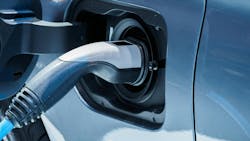As more electric vehicles hit the road, more drivers seem to be hitting a wall with the battery charging experience. Media coverage and studies of the problem of malfunctioning charging stations have been growing, feeding the narrative that electric vehicles aren’t ready for prime time (Figure). And that’s a potentially critical issue given commitments that automakers and policymakers are making to EVs.
A recent J.D. Power study finds the charging infrastructure in several states leading the way in developing public charging “inadequate and plagued with non-functioning stations.” Even as more chargers are rolled out and experience with installation presumably grows, customer satisfaction with the public charging broadly is flagging, posing potential problems for consumer confidence in EVs, it says.
In a press release, J.D. Power quoted Brent Gruber, its executive director of global automotive, saying that “public charging continues to provide challenges to overall EV adoption and current EV owners alike. Not only is the availability of public charging still an obstacle, but EV owners continue to be faced with charging station equipment that is inoperable.”
A key finding was that one in five respondents to a survey of users who stopped at a charging station didn’t end up charging. Three-quarters of those who didn’t charge said it was due to the unit being out of service or malfunctioning. The upshot: “the industry needs to do a better job of maintaining existing charging stations.”
The issue has garnered coverage from a host of outlets, including The New York Times; Autoweek; Car and Driver; and The EV Report. That coverage explores installation, electrical interconnection and communications interface problems, as well as the post-installation maintenance angle.
An examination of the problem is justified because of the stakes, says the executive director of the Electric Vehicle Infrastructure Training Program, which teaches licensed electricians how to properly install, service and maintain EV charging systems. Bernie Kotlier, also the EVITP’s national co-chair, says statistics showing 15% to 25% of stations have some reliability and performance issues are concerning because consumer acceptance, EV growth, and even safety concerns will only be magnified as EV infrastructure expansion accelerates.
“This challenge is in its infancy,” he says. “The number of stations in operation now is small compared to what we’re going to have in five years – in California alone there are fewer than 100,00 and by 2030 there could be 1.2 million. This is a concern now, but the test will be what happens over the next three to five years and beyond.”
With causes ranging from poor installation, power quality/supply issues, and substandard maintenance to defective equipment, communications protocol problems, and programming glitches, charging station malfunctions resist silver-bullet solutions, Kotlier explains. But design, installation, and ongoing maintenance performed by electrical professionals who fully understand EV charging infrastructure should be table stakes at the outset, he says. Before installation, it’s vital that installers – including fully trained and experienced electricians – understand the many nuances of EV charging, he adds, all of which are covered in proven training programs like EVITP, the one the U.S. Department of Transportation’s $5-billion National Electric Vehicle Infrastructure initiative requires charger-installing electricians to complete.
While only a fraction of charger malfunctions might be directly linked to electrical design or installation incompetence, the expected pickup in charger installations raises the risk that more stations might enter service in a hobbled state, prone to failure because of corner cutting. With the success of the EV revolution riding heavily on seamless charging, Kotlier says professional charger installation and maintenance will be essential. But that’s not at all guaranteed. A worrisome development, he says, is the emergence of a less trained class of worker to handle an all-important element of the charger malfunction issue: fixing problems that arise.
“Some EV charger training programs are claiming to teach technicians, not electricians, to do some of the maintenance and repair of charging stations,” he says.
That’s a recipe, he says, for trouble, of a type that the precarious EV infrastructure rollout effort can’t afford.
About the Author
Tom Zind
Freelance Writer
Zind is a freelance writer based in Lee’s Summit, Mo. He can be reached at [email protected].

